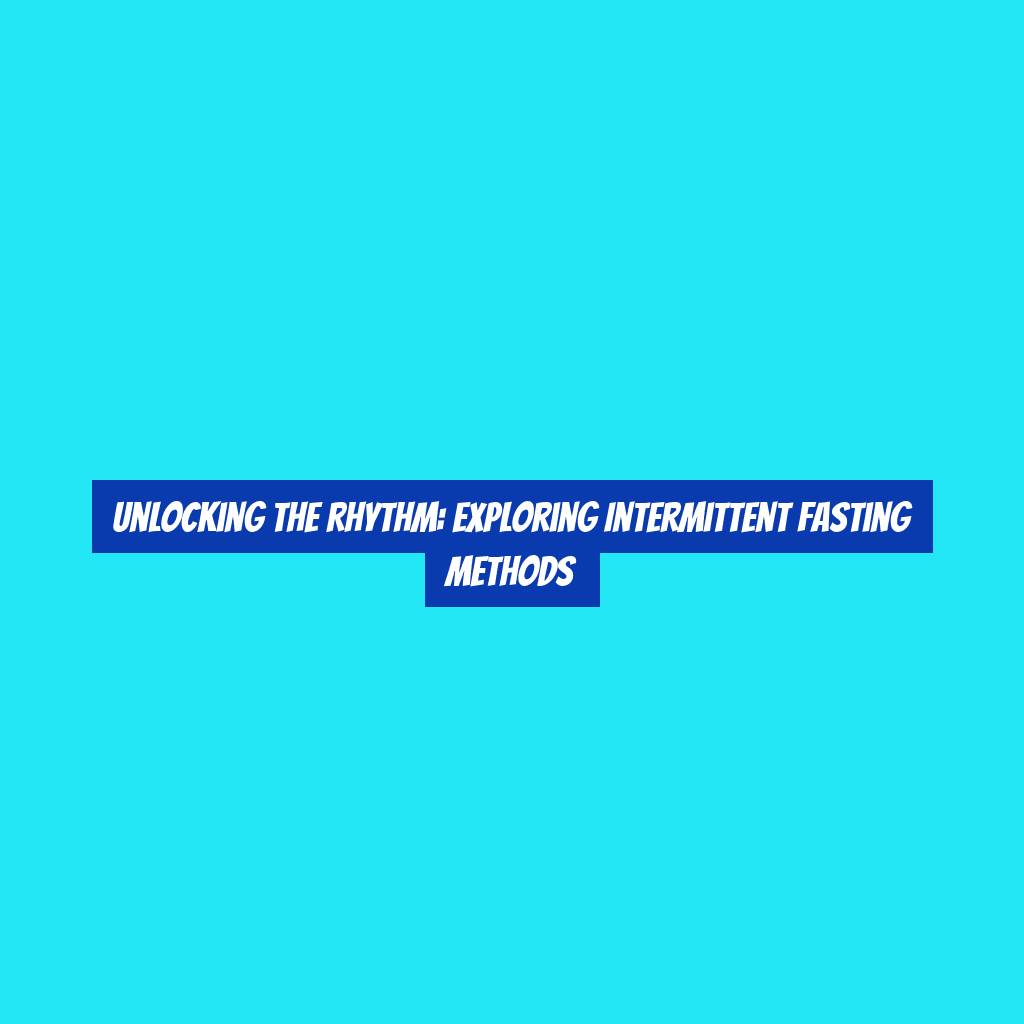Unlocking the Rhythm: Exploring Intermittent Fasting Methods
YouG??ve probably heard about intermittent fasting and its potential health benefits, but have you ever considered the various methods within this approach?
From the popular 16/8 method to the intriguing Warrior Diet, there are several ways to incorporate intermittent fasting into your lifestyle.
Each method offers unique insights into how our bodies respond to periods of fasting and feasting. Exploring these different approaches can provide a deeper understanding of how intermittent fasting can be tailored to fit individual preferences and goals.
The 16/8 Method
You can start the 16/8 method by restricting your eating window to 8 hours each day and fasting for the remaining 16 hours. This means that you might choose to eat between 12 pm and 8 pm, for example, and then fast from 8 pm until 12 pm the following day.
During the fasting period, itG??s important to stay hydrated by drinking water, herbal teas, or other non-caloric beverages. This method is popular because itG??s relatively easy to follow and can be adapted to suit your lifestyle. For instance, if youG??re not a breakfast person, you can simply skip it and start your eating window later in the day.
Additionally, this approach can help regulate your hunger hormones and may lead to reduced calorie intake, potentially aiding weight loss. ItG??s essential to focus on consuming nutritious, balanced meals during your eating window to ensure that youG??re meeting your bodyG??s needs. Remember to listen to your body and make adjustments as necessary to find what works best for you.
Alternate-Day Fasting
Transitioning from the 16/8 method, alternate-day fasting involves alternating between days of regular eating and days of significant calorie restriction or complete fasting. On fasting days, individuals typically consume around 25% of their normal caloric intake, while on non-fasting days, they eat without any specific restrictions. This method has gained popularity due to its flexibility and potential health benefits.
During fasting days, itG??s important to stay well-hydrated and focus on consuming nutrient-dense foods to support overall well-being. While some people find it challenging to adhere to the strict fasting requirements, others appreciate the clear boundaries and the opportunity to indulge in regular eating on alternate days.
Research suggests that alternate-day fasting may lead to weight loss and improvements in various health markers, including cholesterol levels, blood pressure, and insulin sensitivity. However, itG??s crucial to approach this method with caution, especially for individuals with underlying health conditions or those who are prone to disordered eating patterns.
As with any fasting regimen, itG??s essential to consult with a healthcare professional before embarking on alternate-day fasting to ensure that it aligns with your personal health goals and needs.
The 5:2 Diet
Occasionally referred to as the G??fast diet,G?? the 5:2 Diet involves eating normally for five days of the week and restricting calorie intake on the remaining two days. This intermittent fasting method is gaining popularity for its simplicity and flexibility. HereG??s what you need to know about the 5:2 Diet:
-
Caloric Restriction: On the two fasting days, individuals typically consume around 500-600 calories, usually divided into two small meals.
-
Non-Consecutive Fasting Days: ItG??s recommended to space out the two fasting days throughout the week to avoid consecutive fasting, such as fasting on Mondays and Thursdays.
-
Nutrient-Rich Foods: On fasting days, focus on consuming nutrient-dense foods to ensure that your body still receives essential vitamins and minerals.
-
Hydration: Staying well-hydrated is crucial, so make sure to drink plenty of water on fasting days to support your body through the lower calorie intake.
-
Gradual Adaptation: Some individuals find it helpful to gradually ease into the 5:2 Diet by starting with a higher calorie intake on fasting days and gradually reducing it over time.
The 5:2 Diet offers a balanced approach to intermittent fasting, allowing for regular eating patterns for the majority of the week while still reaping the benefits of intermittent fasting.
Eat-Stop-Eat
The 5:2 Diet offers a balanced approach to intermittent fasting, and now we shift our focus to the intermittent fasting method known as Eat-Stop-Eat. With Eat-Stop-Eat, you fast for a full 24 hours once or twice a week. During the fasting period, you abstain from consuming any calories, allowing your body to fully enter a fasted state. This method emphasizes flexibility, as you can choose which days to incorporate the 24-hour fast based on your schedule and personal preferences.
One of the key benefits of Eat-Stop-Eat is its simplicity. By fasting for a full day, you can simplify your approach to intermittent fasting and avoid the need for complex meal planning or calorie counting on fasting days. This method also allows for greater calorie restriction, which may lead to improved weight loss and metabolic health. Additionally, fasting for a full 24 hours can help reset your hunger cues and improve your relationship with food.
ItG??s important to note that during non-fasting days, itG??s essential to maintain a balanced and nutritious diet to support overall health and well-being. As with any fasting method, itG??s advisable to consult with a healthcare professional before starting Eat-Stop-Eat, especially if you have any underlying health conditions.
Warrior Diet
If youG??re looking for an intermittent fasting method that emphasizes under-eating during the day and a single large meal at night, the Warrior Diet may be the right approach for you. This method is based on the eating patterns of ancient warriors and involves a daily fasting period of up to 20 hours, followed by a 4-hour eating window in the evening. HereG??s what you need to know about the Warrior Diet:
-
Under-eating during the day: The Warrior Diet encourages consuming small amounts of raw fruits and vegetables, as well as light protein sources such as boiled eggs or small portions of lean meat during the fasting period.
-
Feasting at night: The main meal of the day is consumed during the 4-hour eating window, allowing for a large, satisfying meal that includes a balance of protein, healthy fats, and carbohydrates.
-
Emphasis on whole foods: The diet prioritizes whole, nutrient-dense foods to support overall health and well-being.
-
Adaptability: It can be adapted to individual preferences and dietary restrictions, making it accessible to a wide range of people.
-
Potential benefits: Proponents claim that the Warrior Diet can lead to fat loss, improved energy levels, and mental clarity, although more research is needed to fully understand its effects.
Conclusion
So, whether you prefer the 16/8 method, alternate-day fasting, the 5:2 diet, eat-stop-eat, or the warrior diet, intermittent fasting can be a flexible and effective way to improve your health and unlock your bodyG??s natural rhythm.
Experiment with different methods and find what works best for you, and remember to consult with a healthcare professional before making any significant changes to your eating patterns.
Embrace the rhythm of intermittent fasting and discover the benefits for yourself.





